Edit: Fortunately for me, someone else did take pictures! And gave permission to use them! All photos taken by and used with permission of Jim Keiter. Thanks Jim!
From the tour, it was a little hard to really see what was going on in the paper mill. Yes, there were bunches of giant rollers making and moving paper, but you couldn't really see the paper. Yes, there were big tanks and machines pulping and de-inking the paper, but you couldn't see inside. The two tangible things we saw were the bales of paper fresh off the trucks (hauled in from various material recovery facilities, which is who sorts out your curbside recyclables and commercial materials from businesses),
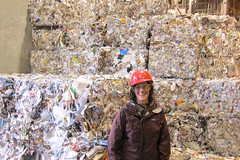
and some of the pulped paper mush mixed in with contaminants.
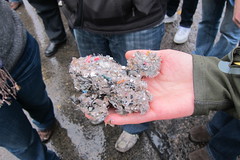
And by "contaminants", I mean pop bottles, CDs, tin cans, and whatever else made it past the sorting stage at the material recovery facilities. Of the tons and tons of material brought in to make their paper products, they lose about 15% to unusable paper fibers (at some point, fibers get to where they are just so used up, they can't bind into new paper anymore, and are lost in the pulping and pressing processes) and contaminant materials. But wow, the turn-around!
Material, trucked in from as close as up the river and as far away as Idaho, is brought to the mill first thing in the morning. Six hours later, the finished paper is trucked out again to become newspaper inserts, fast food to-go bags, and independent newspapers.
After Blue Heron, we visited KB Recycling, a material transfer station. As of this writing, their website was under construction, but you can find some information on them on this page.
Here in the Portland Metro area, we put out our recycling in two wastestreams: glass (in a bucket by itself) and metal/paper/plastic (all together in a big rolling cart). KB takes material brought from curbside recycling and sort it back out into individual material piles. The idea is that residents are more likely to recycle more materials if they can just pile it all into one bin rather than bundle each material separately. It also makes for less contamination overall – overall, the workers at KB sort the truckloads of waste much more effectively than individual residents sort out their own materials.
So, here’s what happens at KB: Trucks bring in residential recyclables that have been put out curbside. The trucks dump their tightly-bundled loads on the floor of the station, the bundled material gets fluffed out and scooped up onto a big machine that transports material up onto a conveyor belt several feet up off the floor while letting cardboard fall through into a pile underneath.

Workers sort materials off the conveyor belt by hand – metal goes through this chute, plastics go through another, trash through another, while leaving paper on the conveyor belt until the end. Whatever’s left on the conveyor belt gets dumped off into a pile, then rerouted up another machine that sorts paper vs. cardboard as best it can, and then through one more conveyor belt for one last sort. Not one part of the process sorts everything out 100%, but they do a pretty good job.
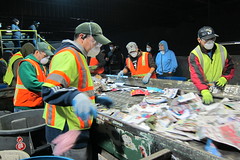
Once a single-material pile is big enough, it gets shoved across the floor of the station to another conveyor. Workers here go through it briefly one last time for contaminants (anything that isn’t the target material) while, for instance, the cans get loaded into the bundler. The cans will get squashed into a 2,600 pound bundle to be shipped off to a metal reprocessor.
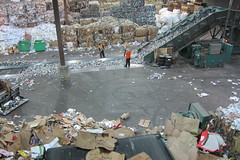
Our tour guide walked us past stacks of bundled materials all waiting to be trucked off to their respective reprocessors. The metal, paper, cardboard, aerosol cans, aluminum foil, and glass will probably stay fairly local – very likely in state or along the west coast. Unfortunately, there’s no good market for the plastics on this side of the country, so plastics almost categorically get shipped off to China. They also take a variety of electronics and appliances, but may require a fee to do so. It’s best to call ahead of time to check if they’ll take it at all and whether a fee is required.

Bundles of plastic waiting to be shipped to China.
Last on our list was Metro Central transfer station. This was also a difficult tour for me – again, lots of noise which made it hard to hear our tour guide and our class leader, so I don’t have as much information as I’d like. While run by Recology, the recovery station is owned by Metro.
They accept a variety of recyclable materials, not just what can be recycled at curbside. They will also take a certain amount of non-recyclable material, for a fee.
They will also take materials that can be donated to a couple of organizations, making this a fantastic place to go when you’re looking to clean out your basement, attic, and garage.
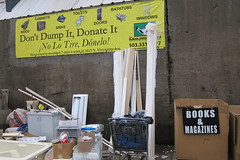
They’ll even take your dumpster after residential/personal home remodeling, and sort that out into recyclable and nonrecyclable items.
We also had a tour of Metro’s Hazardous Waste facility.
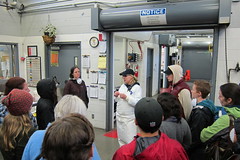
They’ll take everything from window cleaner & solvents to the red biohazard sharps containers, from propane tanks (empty or not) to fertilizers & pesticides. They’ll also happily take your leftover paint and recyle it!

The tour of the hazardous waste facility was awesome. She told us about the facility being on a first name basis with folks in the local bomb squad, as they occasionally receive… “questionable materials” such as ammunition and hand grenades (live ammo? live grenades? Who knows!), explosives used forever ago in agriculture for removing stumps (as a complete aside, check out “Farming With Dynamite” as published by DuPont), and no doubt much, much more. She showed us the lab where they figure out what that unlabeled mayonnaise jar of mystery liquid is, so they can dispose of it properly. Kids, stay in school, get good grades in chemistry, and you too could be handling mystery liquids and potential explosives brought to you by random strangers clearing out their garages and basements.
(Habla espanol? Leer esto!)
The one big thing I learned from our field trip? How badly plastic bags mess up the whole process! The giant machine used to separate cardboard from all the other recyclables? They have to shut it down every couple of hours because plastic bags wind themselves around the tines and gum the machine all up, making it useless. Which means someone has to climb up onto the machine and take the bags off by hand.

The lighter-colored blurs are plastic bags whipping around, and some of the beige blurs are plastic bags already entwined in the ‘teeth’ of this machine.
Yes, they shut down the machine, but that’s still dangerous work, being done several times a day. And every time they shut down the machine, that’s dollars lost to the recovery facility, which means it’s more expensive for them to accept and transfer our household waste, which trickles down into YOUR garbage bill. It’s in YOUR best interest to KEEP PLASTIC BAGS OUT OF YOUR RECYCLING BINS! Reuse them until they fall apart! Take them to the grocery store, if yours accepts them for recycling (it is possible to recycle them, just not curbside!!). Or put them in the trash. Really. It’s okay. It’s not optimal, but it’s the lesser evil.
photos taken by and used with permission of Jim Keiter
Love the pics! Thank you for a great post. :)
ReplyDelete